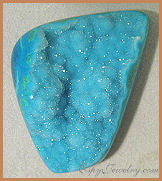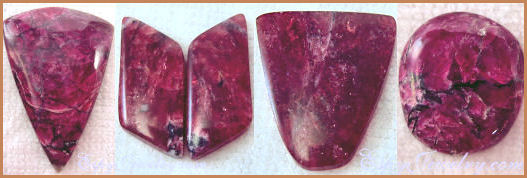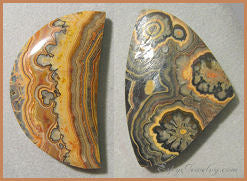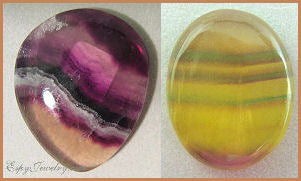Cabs D-H
Cabochons Index by Name
A B C D E F G H I J K L M N O P Q R S T U-V W X-Y-Z
Dendrite
A mineral crystallizing in another mineral in the form of a branching, tree-like growth. Dendrites are often black or dark brown.
Dendritic Agate
Agate with embedded dendrites.
Druse

Druse refers to a crust of tiny crystals on the surface of a rock or mineral. Druse normally forms as a lining inside a cavity in a rock.
All of the mineral references I have spell the word "druse". You will see many variations on the web however - drusy, druze, druzy, drusies, etc.
Technically druse refers to crystals that are so tiny as to not be distinquishable with the naked eye. As you move the druse, the crystal surfaces cause the stone to sparkle and glitter.
Druse can be transparent quartz crystals that reflect the color of the host it is sitting on, like druse chrysocolla, or it can be another mineral providing a color of its own, like dark blue cornetite druse on chrysocolla.
In the jewelry world, druse is commonly used to refer to any cabochon with a surface coating of crystals, even if they are fairly large.
Shown in the picture above, moving from left to right -
o cornetite druse on chrysocolla with some malachite, from Zaire
o black/dark brown garnet crystal crust on host rock, from Russia
o cobalto calcite from Zaire
o orange calcite druse from Mexico
This picture is druse chrysocolla -

Some popular druses -
Chalcedony Druse is a purplish blue chaldedony druse.
Chrysocolla Druse is a wonderful blue color and reminds me of a sno-cone. It is a crust of tiny transparent quartz crystals over chrysocolla.
Cobalto Calcite Druse is a crust of pink crystals on a host rock. It comes from Zaire, Africa and the pink color is due to cobalt. The mineral is sphaerocobaltite, also called cobalticalcite and cobaltian calcite, which is a cobalt carbonate in the calcite group. It ranges from a light pink to a dark magenta color. The more intense hot pink colors come from purer forms of sphaerocobaltite. The paler pinks either only have trace amounts of cobalt or are intergrown with calcite.
Hemimorphite Druse is a wonderful blue color similar to chrysocolla druse, but a bit paler and brighter. It is a crust of tiny transparent quartz crystals over hemimorphite.
Uvarovite Garnet Druse is a crust of emerald-green garnet crystals on a host rock. It comes from Russia and the green color comes from chromium.
Eudialyte - Mohs 5 - 5.5

Eudialyte is a rare stone that comes in colors ranging from red-violet to plummy-red to pink, blue, yellow and brown. Some of it will show mica-like sparkles as light hits it. Some of it reminds me of crackled glass as you look into it. And some of it has great patterns from the black or white matrix that is intermixed with it.
Eudialyte is made up of a bunch of different minerals, including sodium, calcium, cerium, iron, manganese, zirconium, silicon, hydrogen, and chlorine. Eudialtye crystals are found intermixed with black, grey, and/or white matrix. As the amount of matrix in a piece increases, the value decreases, unless the pattern is compelling.
Eudialyte is found several places, including Greenland and Arkansas, but I find that what I buy either comes from Canada (Mont Saint-Hilaire in Quebec) or Russia (Kola Peninsula). My personal opinion is that the eudialyte from Canada normally has a redder color, while the eudilyte from Russia can look more purple-red.
Faustite
See Turquoise.
Feldspar
Any of a group of common rock-forming minerals that have similar characteristics due to similar structures. Plagioclase feldspars include albite, oligoclase, andesine, labradorite, bytownite, and anorthite. The K-feldspars include microcline, sanidine, and orthoclase.
Some popular feldspars are moonstone, sunstone, labradorite, and amazonite.
Flint - Mohs 7

Flint is a type of chalcendony quartz. If you are like me and think of flint as being a dull grey stone used for starting fires or as arrow heads, they you’ll be just as surprised to find out that that it can come in great colors. The colors come from impurities in the stone and include reds, pinks, greens, blues, purples, and yellows, as well as the greys, whites, and blacks.
Ohio flint is especially known for its great colors and its suitability for use in jewelry. In 1965, flint was named Ohio’s official gemstone. The most famous deposit in Ohio is Flint Ridge and was a source for flint for hand tools for pioneers, Indians, and earlier man.
Flowering Tube Onyx

A type of chalcendony quartz that features ornate flowery eyes surrounded by bold concentric bandings.
Fluorite - Mohs 4

Also called Fluorspar. Fluorite is a soft stone that can be brittle. It is prized for its glassy luster and wide variety of colors. The most recognized colors of fluorite are its beautiful ranges of purples. It is also found in blues, greens, yellows, browns, pinks, blacks, reddish oranges, and colorless. Only quartz has a larger color range.
Fluorite may be one color or may have bands of color. Fluorite often fluoresces and was the subject of the first studies on fluorescence. Following the naming precedence set by opalescence from opal; the word fluorescence came from fluorite.
The word fluorite comes from the use of fluorite as a flux in steel and aluminum processing. It was originally referred to as fluorospar. Fluorite is a source of fluorine for hydrofluoric acid, fluorinated water, and fluorides to help prevent cavities.
Fluorspar
See Fluorite.
Fossil Coral
See Indonesian Fossil Coral.
Fuchsite - Mohs 2 - 3

Fuschite is a green muscovite (mica) colored by chromium. The fuschite I’ve seen always seems to be mixed up with some other things. The color can range from a dark green, to a sparkly emerald green, to light, almost bluish green. Black and white inclusions are common, as are blue inclusions of kyanite.
Gaspeite - Mohs 4.5 - 5

Gaspeite is a medium green stone, in the "granny smith apple" range. It may have brown inclusions of host rock which can form pretty patterns. It is relatively rare, found in Canada and Australia around nickel sulfide deposits. It may form translucent crystals, but is normally opaque.
Gemsilica
See Chrysocolla.
Hawks Eye
Hawks Eye is a blue variant of tiger eye.
See Hawks Eye under Tiger Eye for pictures and more information.
Hemimorphite
Hemimorphite is a zinc silicate that is primarily of interest to the jewelry world in its blue and greenish blue colors. It can also be white, beige, tan, sometimes yellowish or colorless.
The name hemimorphite comes from the Greek hemi, meaning half and morph, meaning shape because it has the unique habit of forming different shapes on either end of loose crystals. It has two distinct forms, a well-crystallized one and a microcrystalline globular one.
Hemimorphite used to be called calamine, but it has since been discovered that calamine was actually composed of two distinct minerals - hemimorphite and smithsonite.
Cabochons Index by Name
A B C D E F G H I J K L M N O P Q R S T U-V W X-Y-Z
A B C D E F G H I J K L M N O P Q R S T U-V W X-Y-Z
D
Dendrite
A mineral crystallizing in another mineral in the form of a branching, tree-like growth. Dendrites are often black or dark brown.
Dendritic Agate
Agate with embedded dendrites.
Druse

Druse refers to a crust of tiny crystals on the surface of a rock or mineral. Druse normally forms as a lining inside a cavity in a rock.
All of the mineral references I have spell the word "druse". You will see many variations on the web however - drusy, druze, druzy, drusies, etc.
Technically druse refers to crystals that are so tiny as to not be distinquishable with the naked eye. As you move the druse, the crystal surfaces cause the stone to sparkle and glitter.
Druse can be transparent quartz crystals that reflect the color of the host it is sitting on, like druse chrysocolla, or it can be another mineral providing a color of its own, like dark blue cornetite druse on chrysocolla.
In the jewelry world, druse is commonly used to refer to any cabochon with a surface coating of crystals, even if they are fairly large.
Shown in the picture above, moving from left to right -
o cornetite druse on chrysocolla with some malachite, from Zaire
o black/dark brown garnet crystal crust on host rock, from Russia
o cobalto calcite from Zaire
o orange calcite druse from Mexico
This picture is druse chrysocolla -

Some popular druses -
Chalcedony Druse is a purplish blue chaldedony druse.
Chrysocolla Druse is a wonderful blue color and reminds me of a sno-cone. It is a crust of tiny transparent quartz crystals over chrysocolla.
Cobalto Calcite Druse is a crust of pink crystals on a host rock. It comes from Zaire, Africa and the pink color is due to cobalt. The mineral is sphaerocobaltite, also called cobalticalcite and cobaltian calcite, which is a cobalt carbonate in the calcite group. It ranges from a light pink to a dark magenta color. The more intense hot pink colors come from purer forms of sphaerocobaltite. The paler pinks either only have trace amounts of cobalt or are intergrown with calcite.
Hemimorphite Druse is a wonderful blue color similar to chrysocolla druse, but a bit paler and brighter. It is a crust of tiny transparent quartz crystals over hemimorphite.
Uvarovite Garnet Druse is a crust of emerald-green garnet crystals on a host rock. It comes from Russia and the green color comes from chromium.
E
Eudialyte - Mohs 5 - 5.5

Eudialyte is a rare stone that comes in colors ranging from red-violet to plummy-red to pink, blue, yellow and brown. Some of it will show mica-like sparkles as light hits it. Some of it reminds me of crackled glass as you look into it. And some of it has great patterns from the black or white matrix that is intermixed with it.
Eudialyte is made up of a bunch of different minerals, including sodium, calcium, cerium, iron, manganese, zirconium, silicon, hydrogen, and chlorine. Eudialtye crystals are found intermixed with black, grey, and/or white matrix. As the amount of matrix in a piece increases, the value decreases, unless the pattern is compelling.
Eudialyte is found several places, including Greenland and Arkansas, but I find that what I buy either comes from Canada (Mont Saint-Hilaire in Quebec) or Russia (Kola Peninsula). My personal opinion is that the eudialyte from Canada normally has a redder color, while the eudilyte from Russia can look more purple-red.
F
Faustite
See Turquoise.
Feldspar
Any of a group of common rock-forming minerals that have similar characteristics due to similar structures. Plagioclase feldspars include albite, oligoclase, andesine, labradorite, bytownite, and anorthite. The K-feldspars include microcline, sanidine, and orthoclase.
Some popular feldspars are moonstone, sunstone, labradorite, and amazonite.
Flint - Mohs 7

Flint is a type of chalcendony quartz. If you are like me and think of flint as being a dull grey stone used for starting fires or as arrow heads, they you’ll be just as surprised to find out that that it can come in great colors. The colors come from impurities in the stone and include reds, pinks, greens, blues, purples, and yellows, as well as the greys, whites, and blacks.
Ohio flint is especially known for its great colors and its suitability for use in jewelry. In 1965, flint was named Ohio’s official gemstone. The most famous deposit in Ohio is Flint Ridge and was a source for flint for hand tools for pioneers, Indians, and earlier man.
Flowering Tube Onyx

A type of chalcendony quartz that features ornate flowery eyes surrounded by bold concentric bandings.
Fluorite - Mohs 4

Also called Fluorspar. Fluorite is a soft stone that can be brittle. It is prized for its glassy luster and wide variety of colors. The most recognized colors of fluorite are its beautiful ranges of purples. It is also found in blues, greens, yellows, browns, pinks, blacks, reddish oranges, and colorless. Only quartz has a larger color range.
Fluorite may be one color or may have bands of color. Fluorite often fluoresces and was the subject of the first studies on fluorescence. Following the naming precedence set by opalescence from opal; the word fluorescence came from fluorite.
The word fluorite comes from the use of fluorite as a flux in steel and aluminum processing. It was originally referred to as fluorospar. Fluorite is a source of fluorine for hydrofluoric acid, fluorinated water, and fluorides to help prevent cavities.
Fluorspar
See Fluorite.
Fossil Coral
See Indonesian Fossil Coral.
Fuchsite - Mohs 2 - 3

Fuschite is a green muscovite (mica) colored by chromium. The fuschite I’ve seen always seems to be mixed up with some other things. The color can range from a dark green, to a sparkly emerald green, to light, almost bluish green. Black and white inclusions are common, as are blue inclusions of kyanite.
G
Gaspeite - Mohs 4.5 - 5

Gaspeite is a medium green stone, in the "granny smith apple" range. It may have brown inclusions of host rock which can form pretty patterns. It is relatively rare, found in Canada and Australia around nickel sulfide deposits. It may form translucent crystals, but is normally opaque.
Gemsilica
See Chrysocolla.
H
Hawks Eye
Hawks Eye is a blue variant of tiger eye.
See Hawks Eye under Tiger Eye for pictures and more information.
Hemimorphite
Hemimorphite is a zinc silicate that is primarily of interest to the jewelry world in its blue and greenish blue colors. It can also be white, beige, tan, sometimes yellowish or colorless.
The name hemimorphite comes from the Greek hemi, meaning half and morph, meaning shape because it has the unique habit of forming different shapes on either end of loose crystals. It has two distinct forms, a well-crystallized one and a microcrystalline globular one.
Hemimorphite used to be called calamine, but it has since been discovered that calamine was actually composed of two distinct minerals - hemimorphite and smithsonite.
Cabochons Index by Name
A B C D E F G H I J K L M N O P Q R S T U-V W X-Y-Z
 Unique, One-of-a-Kind Settings for Unique, One-of-a-Kind Stones
Unique, One-of-a-Kind Settings for Unique, One-of-a-Kind Stones